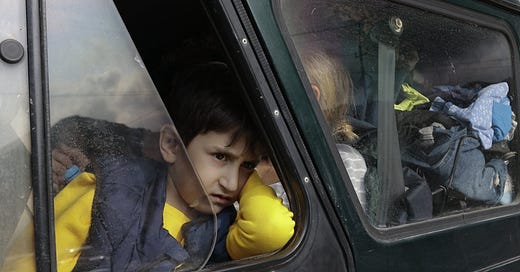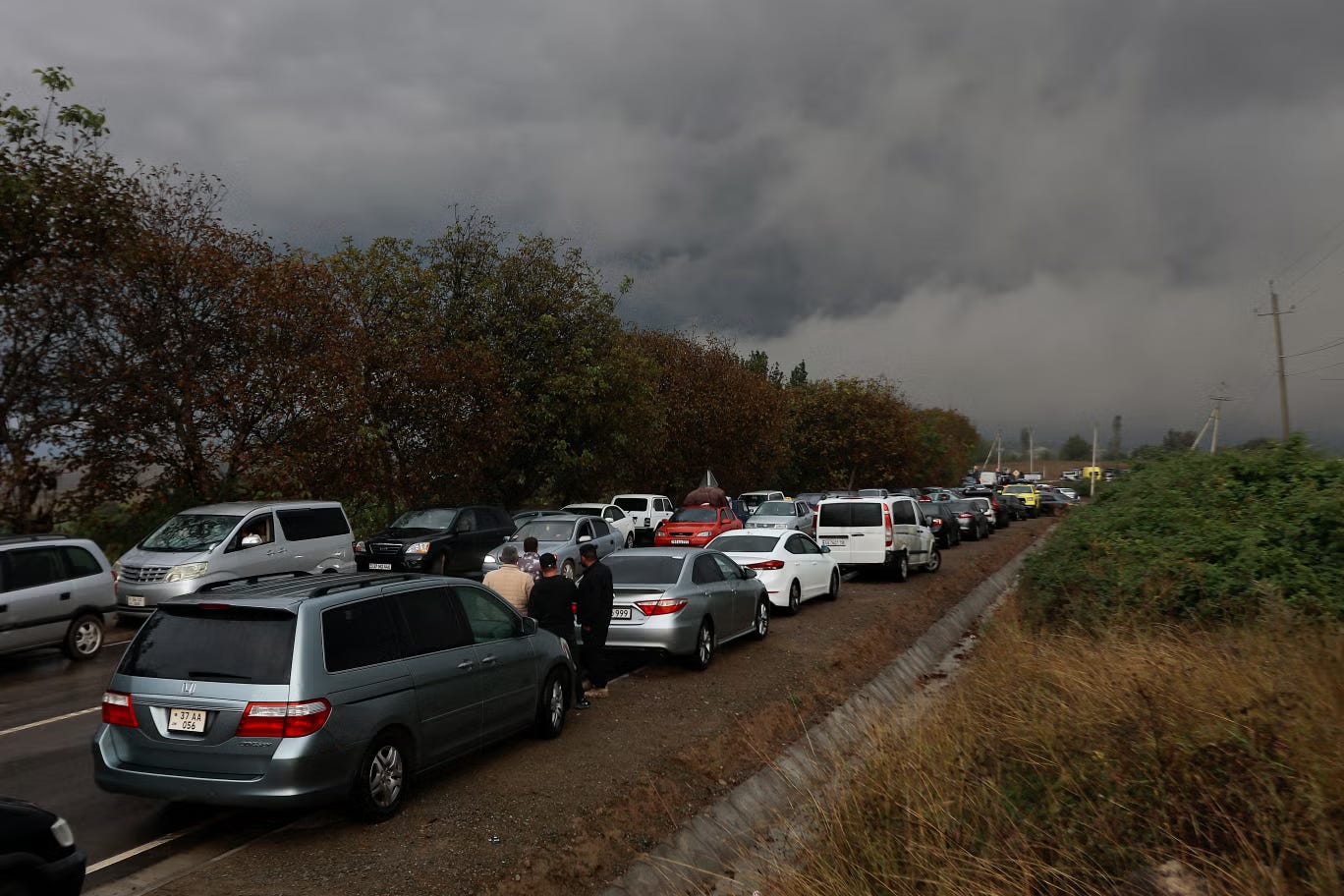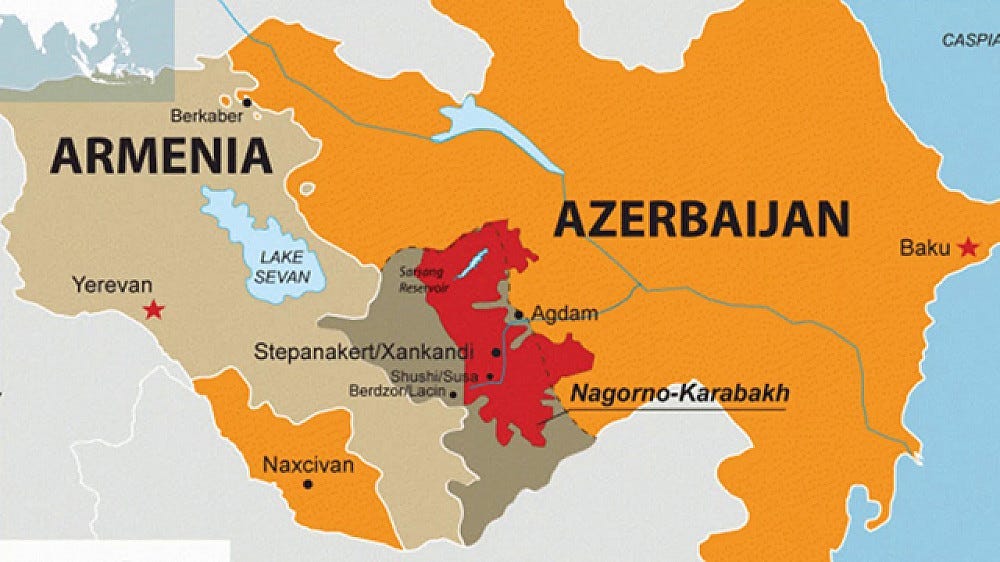Eurasia note #83 - Armenians Flee Karabakh
Yerevan yields Artsakh to Azerbaijan, Russia stands aside
Yerevan and Moscow trade blame for a humanitarian disaster
Has Russia ‘prioritised’ its relations with Turkey and Azerbaijan
Or has Armenia ‘gambled’ with own future and stability of region?
Demands of war, pipelines and trade routes dictate great power politics
Challenging times for smaller nations to defend their integrity
With Russia mired in war, Turkey pitches to expand Turkic bloc
Quick to announce Nakhchivan leg of Trans-Caspian pipeline
Redirecting energy routes to circumvent Russia and Iran
One year since the detonation of the NordStream pipelines
President Erdogan visits Baku to show support for Azerbaijan’s action
Istanbul just hosted 12th meeting of Organization of Turkic States trade ministers
Trade Unions of the Turkic States met this week in Uzbekistan
See also
Azerbaijan Hits Armenia With Turkish Drones (Sep 13, 2022)
Eurasia note #60 – Armenia and Azerbaijan (Sep 23, 2022)
Europe, Gas And The Endgame - Switching energy flow from East-West (Sep 30, 2022)
Eurasia Note #17 - Talk of War and Exit - External forces try to manipulate Russia and Ukraine into conflict; door remains open (Jan 21, 2022)
(2,400 words or 12 minutes of your company)
Tbilisi, Sep 26, 2023
[Update: This was written before we learned that Samantha Power, head of USAID arrived in Yerevan, on Sep 25 to coordinate events.]
As Armenians queued for petrol yesterday evening, filling their cars to flee Artsakh (Nagorno-Karabakh), a petrol station exploded killing at least 20 people and injuring more than 200.
Gasoline has been scarce because of Azerbaijan’s near year-long blockade of the region. The cause of the explosion is not yet established.
It is the latest tragedy in the transfer of Karabakh by Armenia’s prime minister Nikol Pashinyan that many Armenians have protested as a betrayal. Azeri troops took the territory in just 24-hours a week ago.
Regional power Turkey views it as “window of opportunity” to resolve a decades-long dispute.
Armenians have since been trying to leave because they doubt Azerbaijan’s assurances to guarantee their safety.
Pashinyan has staked his career on the capitulation, three decades after Armenian separatists took control of the region. He is also breaking with the country’s traditional reliance on Russia. At the same time, Turkey is taking advantage of Russia’s distraction with war in Ukraine to strengthen its influence in the region. As Azeri forces moved into Karabakh last week, Russian peacekeepers stood aside.
This is an undoubted risk to the survival of a nation. Powers far greater than Armenia have a stake in the outcome. A one-time empire, now a small country, it finds itself in the cross hairs of plans to reorient the energy supply of Eurasia on a South-North, rather than East-West, axis.
Despite membership of the Collective Security Treaty Organization (CSTO), Russia said its forces could not intervene as Armenia had already recognised Nagorno-Karabakh as part of Azerbaijan in talks hosted by the EU.
At one point it seemed the blockade could lead to food shortages. About 14,000 people had fled to Armenia as of Monday night. Another 700 people had taken refuge with Russian peacekeepers.
Turkey, which backs Turkic Azerbaijan, was quick to announce infrastructure measures including a gas pipeline, a parallel railway project, residential construction and electricity infrastructure. The military operation was followed by a visit by Türkiye president Recep Tayyip Erdogan to Azerbaijan.
Politics and geography are complicated by the need for corridors to, from and through the territories.
Azerbaijan has periodically restricted access to the Lachin corridor to Armenia. It has pushed for another corridor, the Zangezur, connecting Azerbaijan via Armenia to its external settlement Nakhchivan, and onwards to Turkey.
The corridor also allows for the above-mentioned Igdir-Nakhchivan pipeline, carrying gas from Turkmenistan to Europe. It trims almost 350 kilometres off the Trans-Caspian pipeline route (TCP) taking Turkmen gas via Azerbaijan, Georgia and Turkey without the need to cross Russia or Iran.
Symbolically the Organization of Turkic States (OTS) was founded in 2006 in Nakhchivan and headquartered in in Istanbul. This month it gathered together trade and economics ministers, as well as a trades unionists.
Turkey backed Azerbaijan in retaking much of Karabakh in 2020 with the use of its drone technology which it is now supplying to Ukraine in its conflict with Russia. Although the treatment of Armenia raised some protests in Europe, the demand for plentiful Turkmen gas won the day — especially since the bombing of the NordStream pipelines exactly one year ago. Leading commentator on the region Yeghia Tashjian writes:
“The diplomatic tension between Armenia and Russia is an outcome of recent geopolitical developments and competition between Russia, the U.S. and their regional allies. Armenia, which was an active player in the regional security architecture before 2018, is now becoming a proxy battleground, where great powers and their regional actors score political goals against each other. Such risks have catastrophic implications for Armenia’s statehood.” [1]
Armenia has traditionally been in Moscow’s sphere of influence, that is until the Pashinyan premiership, who called reliance upon Russia a “strategic mistake.”
The risk is that Pashinyan compromises the support of Russia, and then finds that the European Union and U.S. fail to deliver on whatever promises they have made. Ukrainians experienced this around the 2014 coup when the Brussels dangled membership of the EU. Georgians were left hanging after the West pushed it into a conflict with Russia over Ossetia in 2008.
Others assert that Russia has prioritised its relations with Turkey and Azerbaijan over its traditional ties with Armenia.
But have events really weakened Russia? It is engaging in multi-player politics, in a way that is alien to today’s Western leadership. Iran, for example, stepped up to warn Azerbaijan it would respond to any attack on Armenia (Iran has a large Armenian minority). Russia has to balance these regional interests while leaving no vacuum for the West to intrude.
Outside forces might seek to make trouble in Russia’s “backyard.” Russian forces are present in the former Georgian lands of Abkhazia and Tskhinvali/ South Ossetia. While Georgia protests what it calls the Russian occupation, Russia’s interest in these districts is clearly influenced by what’s on the other side.
You can see the proximity clearly from this map uploaded by the Georgian embassy to the U.S.. It includes Chechnya, Dagestan, Ingushetia, Kabardino-Balkaria and Karachay-Cherkessia.
These autonomous districts of Russia’s North Caucasian Federal District are stricken by poverty and threatened by religious and political instability. Russia, like China, is hugely sensitive to the grievances this can inflame. The interest in border surveillance ranges far beyond the southern Caucasus, to watch for any signs of terrorist training on Afghan soil.
Russian Ambassador to the U.S. Anatoly Antonov has asked Washington to refrain from inflaming “artificial” anti-Russian sentiments in Armenia.
“By doing this, they confirm that the goal of the US and its allies is not the normalization of the situation and peaceful development in Trans-Caucasia, but to inflict strategic damage on Russia and to deliberately destabilize the Eurasian territory with a perspective to push us out of this region.”
He emphasised that Russian troops had died in the effort to maintain peace between Azerbaijani and Armenian peoples.
Rival takes on history
Disputes, in this part of the world, only remain buried if there is a quid pro quo. At his inauguration speech, Azerbaijan’s president Ilham Aliyev said “Present-day Armenia is our land. When I repeatedly said this before, they tried to object and allege that I have territorial claims. I am saying this as a historical fact. If someone can substantiate a different theory, let them come forward.”
Such claims from perpetuity hinge on a particular snapshot in history, and are a potential fig leaf for brute force and expropriation. In this case the habitation of the region by various medieval Turkic khanates.
Once the biggest empire east of Rome, reaching into central Turkey, northern Iran, Syria, Lebanon and Israel, Armenia was the first country in the world to adopt Christianity as a state religion in 301.
In the 5th century the country was split between the Persian empire and the Byzantine, though Armenian nobles played a leading role and several of the emperors of Byzantium were ethnically Armenian.
The nation saw a revival of feudalism in the 9th century and flourished for a short time.
Over the past two millennia Turkic peoples have migrated from western Mongolia “into most of Central Asia from their original homeland in the Altai mountains,” as Akhilesh Pillalamarri has written in The Diplomat. Being nomadic, many of the Turkic tribes clashed with the sedentary population and some served as mercenaries. This led the Seljuk sultans to displace these families to the periphery of the Seljuk empire which bordered Hellenic Byzantium, the eastern portion of what had been the Roman empire.
In 1045 the Byzantines conquered Armenia but, in massing their forces against warlike Turkic tribes, they alerted the Seljuks to their potential threat. In 1071 the Seljuks, who had previously regarded Egypt’s Fatimid Caliphate as their principal rival, set their armies against Byzantium in Manzikert in eastern Turkey.
The rest is history. The largely Greek and Armenian populations came under Turkic rule. Their human heritage of these original genetic markers remain prominent among the Anatolian population today, while in contrast there is relatively little evidence of Central Asian descent: less than 15 per cent.
Another nomadic Turkic migration in the late 6th century were the khagans of Khazaria who established a major commercial empire covering the southeastern section of modern European Russia, southern Ukraine, Crimea, and Kazakhstan.
See Azerbaijan Hits Armenia With Turkish Drones - Western ally once again implicated in attack within Russian borderlands (Sep 13, 2022)
18 months and change
We wrote in Jan 2022, before the Russia’s invasion of Ukraine:
Could the EU go further and re-imagine relations with Russia? President Emmanuel Macron of France makes speeches of that flavour but the reality for now is that France and Germany are wedded to the Atlantic military machine.
Geographically Europe extends to the Ural mountains that traverse Russia north to south, from the Arctic to Kazakhstan. On this map, Russia is Europe’s border to the East and, you could argue that without Russia, Europe would not exist in its current shape.
It has been the buffer for millennia, absorbing multiple invasions by the Mongols among others. Russia owes its origins from Kievan Rus in the 9th century but from the 13th century the Mongol invasions were so brutal and extended that the population dropped by half a million. Over the following 300 years it paid taxes and tributes, its women seized as slaves and sold to the Ottomans.
The rich black-soiled lands that would later become the bread basket of Europe, stretching north of the Black and Caspian seas, across the Pontic steppe were depopulated by hundreds of thousands of people. The economic development of the region that became Ukraine in 1917-20 and again since 1991 was actually held back by these raids.
Today Russia is still Europe’s buffer with some of the rougher parts of world. Though it is some ‘stans away from Afghanistan, its southern border rests against the Caucasus mountains and the colourful lands of Chechnya, Dagestan and Kabardino-Balkaria.
Over more recent years — say 500 or so — Russia has been invaded by Poles, Swedes and French. Germany’s business class historically has seen its destiny to the east, where Russia’s ample energy supplies create a ready market for German goods. That has occasionally combined with political ambition leading to disastrous results. Today this is characterized by a split — the politicians firmly in the Atlantic camp and inclined to use energy as a political weapon and sanctions — to the chagrin of business leaders.
As my former colleague at Sky News, Tim Marshall, has written, had the Ural mountains been further east, Russia and its prime agricultural land would have been left in peace. And so today we find the issue of Crimea: traditionally Russia’s warm water port and a matter integral to the protection of her southern border.
Toll of war
This past week the naval headquarters in Crimea’s biggest city, Sevastopol, was hit with British or American missiles. Some reports claimed U.S. aircraft had provided the coordinates for at least two rockets which hit the roof in quick succession, captured on video by passers by.
Ukraine had claimed it killed the head of Russia’s Black Sea fleet, Viktor Sokolov. It is now “clarifying” that claim after video purported to show him alive.
On the other hand Russia claims it has evidence of direct NATO involvement on the ground, claiming that they destroyed a Leopard II tank complete with a German crew.
The bigger picture is reflected in the Rothschild-owned journal The Economist, which acknowledges that the much-hyped Ukrainian counteroffensive has failed.
“Ukraine has liberated less than 0.25% of the territory that Russia occupied in June. The 1,000km front line has barely shifted.”
Brushing aside the death of an estimated 40,000 Ukrainian men this summer, it urges Ukraine to fight on. A ceasefire would simply be “a pause to re-arm and get ready to attack again. If Ukrainians stop fighting, they could lose their country.”
Europe will eventually need to carry more of the burden, especially if Donald Trump were to win election in 2024.
“That means beefing up its defence industry and reforming the EU’s decision-making so it can handle more members”. [2]
Even before this summer’s deaths, the Kyiv International Institute of Sociology had tried to estimate casualties. It asked Ukrainians whether any of their friends or close relatives had died in the war. Fully 63 per cent of respondents said they had at least one friend or close relative who died in the war.
Noah Carl performed a rough estimate yielding a toll of 188,000 civilian plus military deaths. This is much higher than official estimates but consistent with those of Colonel Douglas Macgregor and Kyiv School of Economics, 7 per cent of whose alumni have been killed. Since that was July, one should add 40,000 to reach 228,000 - or approaching a quarter of a million Ukrainians, and likely similar numbers on the Russian side. [3]
The bankers seem ready to fight to the last European, as they did twice last century. See Hidden History: The Secret Origins of the First World War, Gerry Docherty and James MacGregor (2014) [4]
Also Anthem For Doomed Youth (Moneycircus, Nov 11, 2021)
Sanctions latest
Last week Russia said it would no longer export diesel, except to four former Soviet states Belarus, Kazakhstan, Armenia and Kyrgyzstan. Saudi Arabia also has cut back on oil production, as of course has the Biden administration, and the NordStream pipeline was punctured.
Losing Russian gas has so far cost Germany an estimated 500,000 jobs, and Europe is now has less diesel.
Washington this week sanctioned trade with 11 Chinese and five Russian companies, saying they supplied parts for drones.
The first American-made Abrams tanks have been delivered to Ukraine, according to president Volodymyr Zelenskiy. The Biden administration has not agreed to the U.S Army's ATACMS missiles.
[1] Yeghia Tashjian, Armenian Weekly, Sep 2020 - The Geopolitical Background of the Moscow-Yerevan Rift and Russia’s Future in the Region
[2] The Economist, Sep 21, 2023 - Ukraine faces a long war. A change of course is needed
[3] Noah Carl’s Newsletter, Jul 3, 2023 - How many people have died in Ukraine?
[4] Gerry Docherty and James MacGregor, 2013 - Hidden History: The Secret Origins of the First World War






How quickly the balance of power is changing! Your article reminded me that former P.M. Boris Johnson has Armenian/Turkish/Ashkenazi ancestors and wonder if he will again be inserted as the UK's Prime Minister. They don't seem to elect them any longer.
https://ethnicelebs.com/boris-johnson
And what of Israel's plans to impose their "Heavenly Jerusalem" project whose goal is the formation of a Jewish state within Ukraine on the territories of its five southern regions: Odessa , Dnipropetrovsk , Zaporozhye , Kherson and Mykolaiv .
https://fitzinfo.net/forum/topic/chabads-khazarian-heavenly-jerusalem-project/